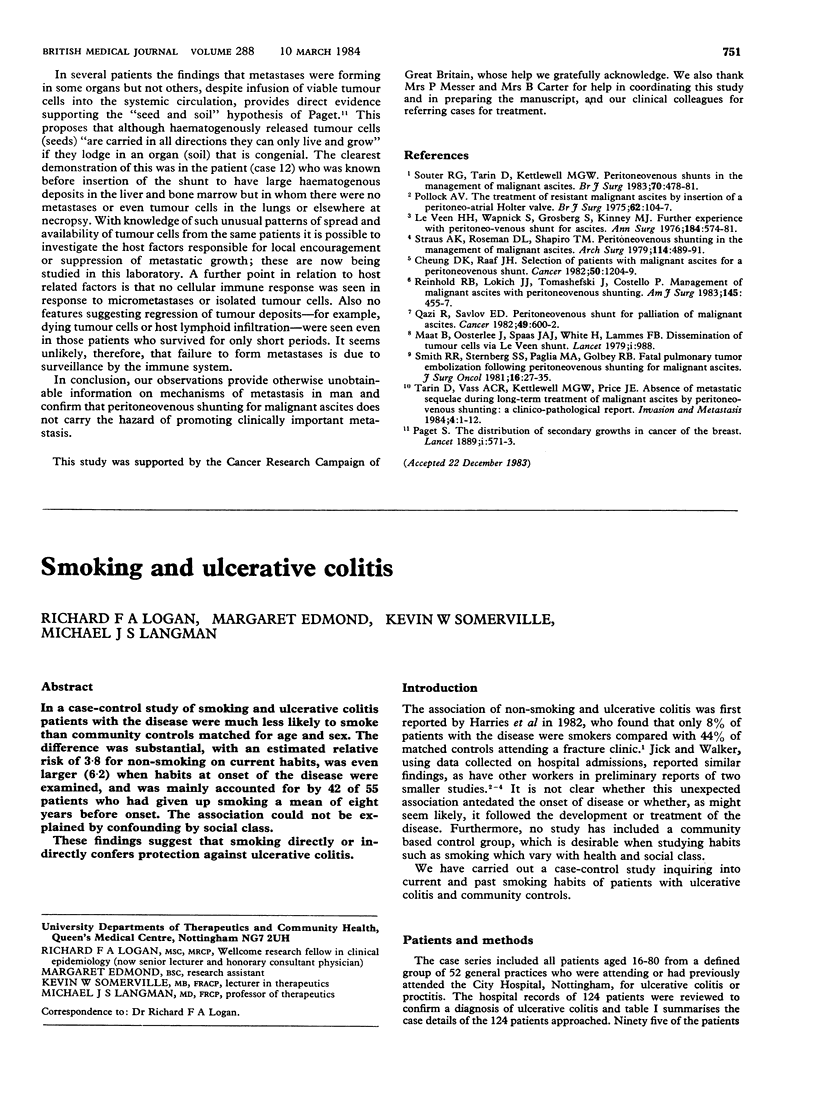Abstract
Fourteen patients with inoperable cancer treated with peritoneovenous shunts for malignant ascites were studied post mortem. Clinical observations and findings at necropsy indicated that peritoneovenous shunting does not result in the establishment of clinically important haematogenous metastases and that metastases do not necessarily develop even when large numbers of viable tumour cells regularly enter the blood. Peritoneovenous shunting provides a unique opportunity for collecting data on the spread of tumours in man.
Full text
PDF


Selected References
These references are in PubMed. This may not be the complete list of references from this article.
- Cheung D. K., Raaf J. H. Selection of patients with malignant ascites for a peritoneovenous shunt. Cancer. 1982 Sep 15;50(6):1204–1209. doi: 10.1002/1097-0142(19820915)50:6<1204::aid-cncr2820500631>3.0.co;2-w. [DOI] [PubMed] [Google Scholar]
- LeVeen H. H., Wapnick S., Grosberg S., Kinney M. J. Further experience with peritoneo-venous shunt for ascites. Ann Surg. 1976 Nov;184(5):574–581. doi: 10.1097/00000658-197611000-00007. [DOI] [PMC free article] [PubMed] [Google Scholar]
- Maat B., Oosterlee J., Spaas J. A., White H., Lammes F. B. Dissemination of tumour cells via LeVeen shunt. Lancet. 1979 May 5;1(8123):988–988. doi: 10.1016/s0140-6736(79)91779-3. [DOI] [PubMed] [Google Scholar]
- Pollock A. V. The treatment of resistant malignant ascites by insertion of a peritoneo-atrial Holter valve. Br J Surg. 1975 Feb;62(2):104–107. doi: 10.1002/bjs.1800620206. [DOI] [PubMed] [Google Scholar]
- Qazi R., Savlov E. D. Peritoneovenous shunt for palliation of malignant ascites. Cancer. 1982 Feb 1;49(3):600–602. doi: 10.1002/1097-0142(19820201)49:3<600::aid-cncr2820490333>3.0.co;2-t. [DOI] [PubMed] [Google Scholar]
- Reinhold R. B., Lokich J. J., Tomashefski J., Costello P. Management of malignant ascites with peritoneovenous shunting. Am J Surg. 1983 Apr;145(4):455–457. doi: 10.1016/0002-9610(83)90039-9. [DOI] [PubMed] [Google Scholar]
- Smith R. R., Sternberg S. S., Paglia M. A., Golbey R. B. Fatal pulmonary tumor embolization following peritoneovenous shunting for malignant ascites. J Surg Oncol. 1981;16(1):27–35. doi: 10.1002/jso.2930160105. [DOI] [PubMed] [Google Scholar]
- Souter R. G., Tarin D., Kettlewell M. G. Peritoneovenous shunts in the management of malignant ascites. Br J Surg. 1983 Aug;70(8):478–481. doi: 10.1002/bjs.1800700809. [DOI] [PubMed] [Google Scholar]
- Straus A. K., Roseman D. L., Shapiro T. M. Peritoneovenous shunting in the management of malignant ascites. Arch Surg. 1979 Apr;114(4):489–491. doi: 10.1001/archsurg.1979.01370280143022. [DOI] [PubMed] [Google Scholar]
- Tarin D., Vass A. C., Kettlewell M. G., Price J. E. Absence of metastatic sequelae during long-term treatment of malignant ascites by peritoneo-venous shunting. A clinico-pathological report. Invasion Metastasis. 1984;4(1):1–12. [PubMed] [Google Scholar]


